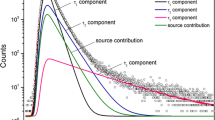Abstract
Free volume effects are important for positronium formation, pick‐off annihilation and chemical reactions. In order to make the method of positron annihilation an effective technique for quantitative studies of molecular solids, for example polymers, the relation between the intensity of the long‐lived component of lifetime distribution of positron annihilation and the number of defects (elementary free volumes) was considered. The analysis assumes selective trapping of positrons and positronium in the defects of ordered and disordered (crystalline and amorphous) sites, respectively, the sizes of nonhomogeneities are assumed to be lower than positron diffusion length. The results on positronium annihilation in porous poly(phenylene oxide) allow one to estimate nontrapped positronium diffusion coefficient which is equal to \(\). The relation between the positronium lifetime and effective size of free volume for large pores (effective radius \(\geqslant \) 1 nm) is considered. Experimental results were obtained using the CONTIN program; some comments on its application for calculations of size distribution of elementary free volumes in polymers are discussed.
Similar content being viewed by others
References
W. Brandt, S. Berko and W.W. Walker, Phys. Rev. 120 (1960) 1229.
W. Brandt and R. Paulin, Phys. Rev. B 5 (1972) 2430.
S.J. Tao, J. Chem. Phys. 56 (1972) 5499.
M. Eldrup, D. Lightbody and J.N. Sherwood, Chem. Phys. 63 (1981) 51.
R.B. Gregory, J. Appl. Phys. 70(9) (1991) 4665.
Q. Deng and Y.C. Jean, Macromolecules 26 (1993) 30.
V.P. Shantarovich, J. Radioanalytical Nucl. Chem. 210 (1996) 357.
D. Dlubek, A.P. Clarke, H.M. Fretwell, S.B. Dugdale and M.A. Alam, Phys. Status Solidi A 157 (1996) 35.
R.N. West, in: Positrons in Solids, ed. P. Hautojarvi (Springer, Berlin, 1979) p. 89.
M. Eldrup, O. Mogensen and G. Trumpy, J. Chem. Phys. 57 (1972) 495.
M. Eldrup, in: Positron Annihilation, eds. P.G. Coleman and S.C. Sharma (Norh-Holland, Amsterdam, 1982) p. 753.
R.L. Miller and R.F. Boyer, J. Polym. Sci.: Polym. Phys. 22 (1984) 2043.
A.V. Goldanskii, V.A. Onischuk and V.P. Shantarovich, in: Positron Annihilation, eds. P.G. Coleman and S.C. Sharma (World Sci., Singapore, 1989) p. 778.
V.P. Shantarovich, V.I. Goldanskii, Y.N. Molin, V.P. Perminov and G.I. Skubnevskaya, Izv. Akad. Nauk SSSR Ser. Khim. Izvestiya, Chemistry 10 (1967) 2188.
W. Brandt and J. Wilkenfeld, Phys. Rev. B: Solid State Phys. 12 (1975) 2579.
F.J. Belta Colleja, J. Serna, J. Vicente and M.A. Segovia, J. Appl. Phys. 58(1) (1985) 253.
O.K. Alekseeva, L.G. Aravin, V.A. Onischuk and V.P. Shantarovich, Physica Scripta 20 (1979) 681.
P.F. James, A. Paul, R.M. Singru, C. Dauwe, L. Dorikens-Vanpraet and M. Dorikens, J. Phys. C: Solid State Phys. 8 (1975) 393.
S.J. Tao and J.H. Green, Proc. Phys. Soc. 85 (1965) 463.
H. Nakanishi, Y.C. Jean, E.G. Smith and T.C. Sandreczki, J. Polym. Sci. B: Polym. Phys. 27 (1989) 1419.
V.P. Shantarovich, V.I. Kleiner, A.Y. Alentiev et al., Khimiya Vysokikh Energii 32(1) (1998) (High Energy Chemistry, in Russian).
M. Maurino and W. Brandt, Bull. Am. Phys. Soc. 24 (1979) 72.
A.Z. Varisov, Sov. Solid State Phys. 28 (1986) 2173.
M. Eldrup, A. Vehanen, P.J. Schultz and K.G. Lynn, Phys. Rev. Lett. 51 (1983) 2007.
A.V. Goldanskii, V.A. Onischuk and V.P. Shantarovich, Phys. Status Solidi A 102 (1982) 559.
V.P. Shantarovich, Y.P. Yampolskii, I.B. Kevdina, Z.K. Azamatova and V.S. Khotimskii, Vysokomolek. Soed. A 39 (1997) 445 (Polymer Sci. A 39 (1997) 287).
Y. Kobayashi, K. Hirata, Y. Ujihira and K. Itoh, J. Radioanal. Nucl. Chem. 210 (1996) 525.
K.V. Waran, K.L. Cheng and Y.C. Jean, J. Phys. Chem. 88 (1984) 2465.
V.P. Shantarovich, Y.A. Novikov, Z.K. Azamatova and Y.P. Yampolskii, Macromolecules 31 (1998) 3963; V.P. Shantarovich, Y.A. Novikov and Z.K. Azamatova, Fizika Tverdogo Tela (Solid State Physics) 40(1) (1998) 164.
I.B. Kevdina, M.S. Arzhakov and V.P. Shantarovich, Vysokomolek. Soed. B 37 (1995) 171 (Polymer Sci. B 37 (1995) 171).
Y. Kobayashi, W. Zheng, E.F. Meyer, J.D. McGervey, A.M. Jamieson and R. Simha, Macromolecules 22 (1989) 2302.
V.P. Shantarovich, Y.P. Yampolskii and I.B. Kevdina, Khim. Vysokikh Energii (High Energy Chemistry) 28 (1994) 53.
L.O. Roellig, in: Positron Annihilation, eds. A.T. Stewart and L.O. Roellig (Academic Press, New York, 1967) p. 127.
Rights and permissions
About this article
Cite this article
Shantarovich, V., Goldanskii, V. Positron annihilation in free volume elements of polymer structures. Hyperfine Interactions 116, 67–81 (1998). https://doi.org/10.1023/A:1012622822148
Issue Date:
DOI: https://doi.org/10.1023/A:1012622822148



